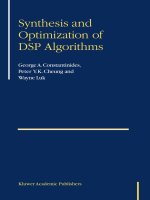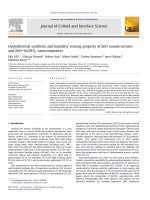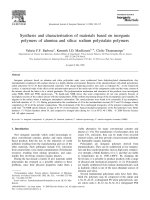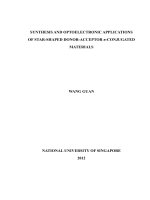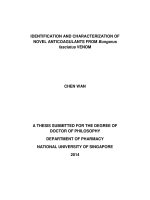Synthesis and blend of bio-based benzoxazines from cardanol and diphenolic acid
Bạn đang xem bản rút gọn của tài liệu. Xem và tải ngay bản đầy đủ của tài liệu tại đây (759.88 KB, 10 trang )
Vietnam Journal of Science and Technology 58 (2) (2020) 246-255
doi:10.15625/2525-2518/58/2/14218
SYNTHESIS AND BLEND OF BIO-BASED BENZOXAZINES
FROM CARDANOL AND DIPHENOLIC ACID
Cao Xuan Viet1, *, Nguyen Thi Le Thanh1, Du Ngoc Uy Lan2, 3
1
Department of Polymer Materials, Faculty of Materials Technology, HCMUT–VNUHCM
268 Ly Thuong Kiet, District 10, Ho Chi Minh City, Viet Nam
2
School of Materials Engineering, University Malaysia Perlis, Kompleks Taman Muhibah,
Jejawi 2, Arau 02600, Malaysia
3
Department of Polymer Engineering, University of Bayreuth, Universitätsstraße 30,
95447 Bayreuth, Germany
*
Email:
Received: 14 August 2019; Accepted for publication: 17 February 2020
Abstract. In this study, two benzoxazine monomers, m-alkylphenyl-3,4-dihydro-2Hbenzoxazine (CA-Bz) and 4,4Ꞌ -Bis-[6-(3-phenyl-3,4-dihydro-2H-1, 3-benzoxazine)] pentanoic
acid (DPA-Bz) were successfully synthesized from fully bio-based phenols (cardanol and
diphenolic acid). Their structures were confirmed by FTIR and NMR spectroscopy. CABz/DPA-Bz blend was prepared at weight ratio of 3:1. Polymerization behavior of the blend was
investigated by DSC. The ring-opening polymerization temperature of CA-Bz was found to
decrease significantly by incorporation of carboxyl groups in DPA-Bz showing thereby the
catalytic effect of acid functionality. The modified polybenzoxazine also showed an
enhancement of the thermal properties.
Keywords: diphenolic acid, cardanol, ring-opening polymerization, benzoxazine blend.
Classification numbers: 2.9.3, 2.10.2, 2.10.3.
1. INTRODUCTION
Polybenzoxazines (PBzs) are relatively a new class of high performance polymers which
display good mechanical strength, low moisture absorption, high service temperature, high char
yield and structure design flexibility, in addition to their zero shrinkage or a slight expansion
upon curing. These fascinating characteristics have made polybenzoxazine more attractive from
both industry and academic parties in recent years, leading to a wide range of applications such
as electronics, composites, blends, and alloys and so on [1-3].
Most of the chemicals used for the synthesis of benzoxazine (Bz) are based on petroleum
resources, which is not easily renewable. Currently, with the rapid development of bio-based
materials, using renewable phenolic derivatives to replace the petroleum-based raw materials for
the synthesis of benzoxazine monomers has gained considerable interest. Cardanol is an
industrial pale-yellow oil extracted from cashew nut shell liquid which is also a promising
renewable phenol resource. Cardanol is the main component of the technical CNS which is
Synthesis and blend of bio-based benzoxazines from cardanol and diphenolic acid
sustainable, inexpensive and largely available as agricultural waste in major parts of the world,
particularly in Viet Nam. Cardanol have been used with other neat resins for properties
improvement in various applications such as structural composites, adhesives, and paints [4-7].
Cardanol-based benzoxazines demonstrated high flexibility due to the presence of the long
soft aliphatic chain, which provides a better processability. However, this benzoxazine has
relatively low mechanical properties due to the low crosslink density of cured products and still
requires a high polymerization temperature [8-9].
It is widely reported that bisphenol A (BPA)-based benzoxazine stands out from many
types of benzoxazines due to its high structural integrity and superior properties [1, 9].
Diphenolic acid (DPA), which has a structure similar to BPA (Figure 1), can be prepared from
low-grade lignin and cellulose biomass resources. DPA is commercially available and much
cheaper than BPA and has the ability to introduce functional carboxyl group into the polymer
structure. Therefore, DPA is believed to be a cheap bio-based compound in large scale and it can
be a good candidate to replace BPA for the synthesis of benzoxazine resin with low curing
temperature [10].
Figure 1. The structure difference between BPA and DPA.
It is well known that one main drawback in benzoxazine chemistry is the high curing
temperature. Two methods have been used to solve this problem: application of highly active
initiators and blending with different benzoxazine monomers. Benzoxazine monomers have been
modified to lower ring-opening polymerization (ROP) by using catalysts such as lithium iodide
(LiI), phosphorus pentachloride (PCl5), p-toluene sulfonate. However, the excess of catalyst used
remain trapped in the polymer network might cause problems such as low thermal stability and
brittleness of obtained materials. The latter approach can overcome such disadvantages since the
added monomer become a part of PBz network and accelerate the ROP [11-12].
In this work, we have synthesized and used a DPA-Bz monomer containing acid
functionality based on diphenolic acid (DPA) to blend with CA-Bz monomer. It is expected that
such a monomer will catalyze the ROP and reduce the curing temperature of cardanol-based
benzoxazine.
2. MATERIALS AND METHODS
2.1. Materials
Cardanol was obtained from Son Chau Co., Ltd (Viet Nam) (Table 1). Prior to synthesis
of CA-Bz, cardanol (C21H36-nO, n = 0, 2, 4, 6) was distilled at 230–240 oC under 2–4 mm Hg.
Diphenolic acid (4,4’-bis(4-hydroxyphenyl) pentanoic acid) (95 %), sodium sulfate (99 %) and
sodium hydroxide (97 %) were purchased from Sigma-Aldrich. Paraformaldehyde (95 %),
247
Cao Xuan Viet, et al.
aniline (99.5 %) and chloroform (99 %) were purchased from Merck. Toluene (99 %) was
provided by Prolabo. The 1,3,5-triphenylhexahydro-1,3,5 triazine was synthesized following a
procedure described by Brunovska, Z. [13]. All chemicals (except cardanol) were used without
further purification. Synthesis reactions were carried out in oven-dried flask.
Table 1. Main characteristics of cardanol.
Characteristic
Test Method
Values
Water Content (by vol/mass) (%)
Relative Density at 25 oC (g/cm3)
Kinematic Viscosity at 25 oC (mm2/s)
Acid Number (mgKOH/g)
Hydroxyl Value (mgKOH/g)
Non-volatile Content (by mass) (%)
ASTM D 95-13e1
ASTM D 4052-11
ASTM D 445-12
ASTM D 664-11a
ASTM D 1957-86
ASTM D 1353-13
0.1
0.94
51.47
0.8
184.8
99.5
2.2. Synthesis of 4,4Ꞌ-Bis-[6-(3-phenyl-3,4-dihydro-2H-1, 3-benzoxazine)] pentanoic acid
(DPA-Bz)
DPA-Bz were synthesized according to the reported procedure as illustrated in Figure 2
[14]. Into a 250 ml round-bottomed flask equipped with a condenser, 1,3,5-Triphenylhexahydro1,3,5-triazine (0.02 mol), paraformaldehyde (0.06 mol), 4,4Ꞌ-bis(4-hydroxyphenyl) pentanoic
acid (0.03 mol) and 100 ml of toluene were added. The mixture was heated with stirring at
110 oC for 6 h. The mixture was cooled to room temperature, filtered and concentrated under
reduced pressure to obtain a light orange syrup. Subsequently, the syrup was dried under high
vacuum to form DPA-Bz as a yellowish powder with a yield of 89 %.
Figure 2. Schematic pathway of synthesis of DPA-Bz monomer.
2.3. Synthesis of m-alkylphenyl-3,4-dihydro-2H-benzoxazine (CA-Bz)
CA-Bz was prepared by our earlier reported solventless method [15]. A mixture of cardanol
(10 g, 0.033 mol), paraformaldehyde (1.98 g, 0.066 mol) and aniline (3 ml, 0.033 mol) was
added into a 100 ml three-necked round-bottomed flask and stirred at 80 oC under nitrogen
atmosphere for 5 h. The mixture was cooled to room temperature and dissolved in chloroform.
The mixture was washed with NaOH 2M and thoroughly washed by distilled water using a
separating funnel. Then, the organic phase was collected, dried with anhydrous sodium sulfate
248
Synthesis and blend of bio-based benzoxazines from cardanol and diphenolic acid
and filtered to give a red oil. The solvent was evaporated under reduced pressure and then dried
at 60 oC for 12 h under vacuum to obtain CA-Bz monomer with a yield of 73 %.
Figure 3. Schematic pathway of synthesis of CA-Bz monomer [15].
2.4. Blend of CA-Bz and DPA-Bz
CA-Bz and DPA-Bz monomers with blend ratio (w/w) of 3:1 were dissolved in chloroform
(10 %, w/w) and stirred at room temperature for at least 1 h to obtain a homogenous solution
form. Subsequently, the solution was dropped and casted on a glass plates. The sample was dried
under vacuum for 2 h at 100 oC. Thermal curing of blend was carried out in a heating oven at
220 oC/2h and further characterized by DSC and FTIR. Similar process was used to prepare CABz and DPA-Bz resin.
2.5. Measurements
Fourier transform infrared (FTIR) spectra were obtained on a Bruker Tensor37
spectrophotometer with a resolution from 4000 – 400 cm-1. The measurement was performed at
Institute of Chemistry Technology, Vietnam Academy of Science and Technology (VAST), Ho
Chi Minh City.
1
H (500 MHz) and 13C (125.8 MHz) nuclear magnetic resonance (NMR) spectra were taken
on a Bruker Avance AM500 FT-NMR spectrometer with CDCl3 as solvent. The NMR
measurements and analysis were done at Center for Apply Spectroscopy, Institute of Chemistry
Technology, Vietnam Academy of Science and Technology (VAST), Ha Noi.
Differential scanning calorimetry (DSC) measurement was done using a Mettler Toledo
thermal analyzer to monitor the polymerization of benzoxazines. Each dynamic scan was
performed by heating a sample at 10 oC/min under nitrogen purge from room temperature to
300 oC. The thermal stability of polymer was studied by thermogravimetric analysis (TGA)
using a TGA Q500 instrument. The thermograms were obtained at a temperature rate of
10 °C/min from 25 °C to 800 °C under nitrogen environment. DSC and TGA characterization
were performed at Central Laboratory for Analysis, University of Science–VNUHCM.
3. RESULTS AND DISCUSSION
3.1. Determination of the structure of DPA-Bz and CA-Bz monomers
The structures of DPA-Bz and CA-Bz monomers were supported by the FTIR spectra
shown in Figure 4. The presence of cyclic ether of DPA-Bz structure was confirmed by the
absorbance peaks at 1232 and 1028 cm-1 due to the C-O-C symmetric stretching and asymmetric
249
Cao Xuan Viet, et al.
stretching modes, respectively. For CA-Bz, these peaks displayed at 1241 and 1031 cm-1,
respectively. There was an obvious characteristic peak of out-of-plane C-H of oxazine ring at
947 cm-1 (959 cm-1 for CA-Bz). The absorbance peak at 1119 cm-1 (1113 cm-1 for CA-Bz) was
attributed to the C-N-C symmetric stretching mode [16].
Figure 4. FTIR spectra of DPA-Bz and CA-Bz monomers.
The expected structure of DPA-Bz was further examined by the NMR results (Figure 5). In
H NMR spectrum, the oxazine protons (O-CH2-N and Ar-CH2-N) gave two signals at 5.32 ppm
(singlet, 4H) and 4.56 ppm (singlet, 4H), respectively. Methyl protons of the DPA appeared at
1.51 ppm (singlet, 3H) while methylene protons of the DPA observed at 2.35 ppm (triplet, 2H)
and 2.13 ppm (triplet, 2H) respectively. The COOH proton was not found in 1H NMR when
CDCl3 is used as solvent. The corresponding 13C NMR spectrum also supported the structure of
DPA-Bz. The oxazine ring carbons (O-CH2-N and Ar-CH2-N) appeared as two singlets at 79.23
ppm and 50.6 ppm, respectively. Most importantly, the signal appeared at 179.1 ppm confirmed
the presence of COOH group in the monomer structure [16].
1
Figure 5. 1H NMR (a), 13C NMR (b) spectra of DPA-Bz monomer.
Similarly, the CA-Bz monomer structure was further confirmed by 1H NMR spectrum in
Figure 6. The resonances peaks at 4.58 and 5.3 ppm were assigned to (Ar-CH2-N) and (O-CH2250
Synthesis and blend of bio-based benzoxazines from cardanol and diphenolic acid
N) of the oxazine ring, respectively. The aromatic protons were observed as multiplet in position
at 6.63–7.26 ppm. The peaks observed at 0.90, 1.29, 1.55, 2.05 and 2.80 ppm appeared due to
the long alkyl chain of cardanol [15].
Figure 6. 1H NMR spectrum of CA-Bz monomer.
3.2. Thermal polymerization of CA-Bz/DPA-Bz blend
Figure 7. DSC thermograms of CA-Bz, DPA-Bz and their blend.
251
Cao Xuan Viet, et al.
Table 2. Data collected from DSC curves of CA-Bz, DPA-Bz and their blend.
Sample
T onset (oC)
T peak(oC)
ΔH(J/g)
CA-Bz
259
274
121
CA-Bz/DPA-Bz
169
202
232
DPA-Bz
140
176
280
Thermal polymerization of individual monomers and CA-Bz/DPA-Bz mixtures was studied
using DSC at a heating rate of 10 °C min-1 under a nitrogen atmosphere from 30 °C to 300 °C.
Figure 7 showed the DSC thermograms with the data summarized in Table 2 including onset
curing temperature (Tonset), temperature of exothermic peak (Tpeak), and heat of curing reaction
(ΔH). The exothermic transitions observed at high temperature region associated to the ring
opening polymerization (ROP of oxazine rings. Heating of benzoxazine produced the ROP by
cleavage of C-O bond, resulted in structure transformation from oxazine ring to a linear open
chain structure. The exothermic peak observed at 274 °C was corresponded to the
polymerization temperature of CA-Bz which was relatively high compared to other
benzoxazines (around 200-250 °C). The onset temperature and peak temperature of DPA-Bz
were 140 and 176 °C respectively, which were much lower than those of CA-Bz. This result
could directly be related to the presence of carboxylic group (COOH) in the structure of DPA-Bz
[14, 17].
Interestingly, the presence of carboxylic group in DPA-Bz showed a profound lowering in
the polymerization temperature of benzoxazine blend with Tonset at 169 and Tpeak at 202 °C. An
increase in the acidity of phenolic groups generated during ROP might be responsible for the
reduction in curing temperature of blend. Despite the difference in the exothermic peak
temperatures of CA-Bz and DPA-Bz, the DSC curve of blend featured only one main peak. This
might indicate the formation of a co-crosslinked polymer network by the copolymerization of
benzoxazines. Therefore, the presence of DPA-Bz was believed to promote the curing reaction
of CA-Bz and improve the crosslinking density of cured resin [11, 18]. Thermal-induced ring
opening polymerization of benzoxazine monomers resulted in formation of polybenzoxazine.
Possible crosslinked network of benzoxazine resin formed by ring opening of two monomers
was depicted in Figure 8.
Thermal stability of cured benzoxazines was further investigated by TGA under nitrogen
atmosphere. The TGA thermograms of polymers from CA-Bz and DPA-Bz and blend were
shown in Figure 9 and TGA data collected from these curves presented in Table 3. Thermal
stability was characterized by determining temperatures for 5 % and 10 % mass loss (T5%, and
T10% respectively), and char yield at 800 oC. The TGA curve of poly (DPA-Bz) showed that
more than one degradation step occurs. The first step (160 to 250 oC) corresponding to a very
small mass loss which could be related to the decomposition of COOH groups and alkyl chain in
pentanoic acid moiety. The major weight loss at temperatures between 260 and 500 oC was due
to the evaporation of amines and degradation of the phenolic moieties, respectively. The final
step was the degradation of the aromatic ring occurred at the temperature above 500 oC.
It can be seen that the main degradation of poly (DPA-Bz) occurred at lower temperature
than poly (CA-Bz), thus the T5%, and T10% of blend was found to be higher in the blend
compared to those of poly (DPA-Bz). A higher char yield of Poly (DPA-Bz) was due to higher
252
Synthesis and blend of bio-based benzoxazines from cardanol and diphenolic acid
aromatic content in its monomer structure. Moreover, slight increase in char yield of the blend
was observed, suggesting that higher crosslink density might be obtained [10, 18].
Figure 8. Possible crosslinked network formed upon ROP of CA-Bz/DPA-Bz blend.
Figure 9. TGA thermograms of CA-Bz, DPA-Bz and their blend.
Table 3. Data collected from TGA curves of cured resin from CA-Bz, DPA-Bz and their blend.
T5% (oC)
T10% (oC)
Char yield at 800 oC (%)
Poly (CA-Bz)
397
461
0.6
Cured CA-Bz/DPA-Bz
371
407
19
Poly (DPA-Bz)
257
299
30
Sample
4. CONCLUSIONS
253
Cao Xuan Viet, et al.
In this work, we have reported the synthesis and structural characterization of two
benzoxazine monomers, CA-Bz and DPA-Bz from fully bio-based phenols. Benzoxazine with
much lower curing temperature was achieved with CA-Bz/DPA-Bz blend as indicated by DSC
analysis. The addition of DPA-Bz containing acid functonality was found to have beneficial
effect on the polymerization of CA-Bz monomer such as accelerating effect on the curing
process and enhancement in crosslink density. Therefore, DPA-Bz has a great potential for
blending with other benzoxazines to overcome the high thermal curing temperature of the
conventional benzoxazine system.
Acknowledgements. The authors would like to thank Ho Chi Minh City University of Technology for
financial support. This research is funded by HCMUT under grant number T-CNVL-2018-67.
REFERENCES
1.
Ishida H., Agag T. – Handbook of benzoxazine resins, Elsevier, 2011.
2.
Ishida H., Froimowicz P., – Advanced and Emerging Polybenzoxazine Science and
Technology, Elsevier, 2017, pp. 451.
3.
Takeichi T., Kawauchi T., and Agag T. – High Performance Polybenzoxazines as a Novel
Type of Phenolic Resin, Polym. J. 40 (12) (2008) 1121–1131.
4.
Vo P., Le T. L., Pham N. L., Raubach H. – Constituent and structure of Cashew Nut Shell
Liquid of Viet Nam, Vietnam Journal of Chemistry 26 (9) (1988) 1–4.
5.
Vo P., L.T. L., Nguyen T. V. T., Hoang N. T., Pham T. H. – Polymer from Cardanol:
Enamel paint for magnet wires derived from Polyvinyl Formal modified with Cardanol
based Phenol Formaldehyde, Vietnam Journal of Chemistry 31 (1) (1993) 1–4.
Nguyen L. H., Nguyen D. T., La T. H., Phan K. X., Nguyen T. T. T., Nguyen H. N. –
6.
Effects of nanoclay on the properties of cardanol–modified–resol–epoxy–novolac
composite material, Journal of Applied Polymer Science 103 (5) (2007) 3238–3242.
7.
Zhang C. Q., Garrison T. F., Madbouly S. A., and Kessler M. R. – Recent advances in
vegetable oil-based polymers and their composites, Prog. Polym. Sci. 71 (2017) 91–143.
8.
Jaillet F., Darroman E., Ratsimihety A., Boutevin B., and Caillol S. – Synthesis of
cardanol oil building blocks for polymer synthesis, Green Materials 3 (3) (2015) 59–70.
9.
Monisha M., Amarnath N., Mukherjee S., Lochab B. – Cardanol Benzoxazines: A
Versatile Monomer with Advancing Applications, Macromol. Chem. Phys. 220 (3) (2019)
1800470.
10. Yan H., Sun C., Fang Z., Liu X., Zhu J., and Wang H. – Synthesis of an intrinsically
flame retardant bio-based benzoxazine resin, Polymer 97 (2016) 418–427.
11. Lochab B., Varma I.K., and Bijwe J. – Blends of benzoxazine monomers, J. Therm. Anal.
Calorim. 111 (2) (2013) 1357–1364.
12. Kotzebue L. R. V., Ribeiro F. W. M., Sombra V. G., Feitosa J. P. A., Mele G., Mazzetto
S. E., and Lomonaco D. – Spectral and thermal studies on the synthesis and catalyzed
oligomerization of novel cardanol-based benzoxazines, Polymer 92 (2016) 189–200.
13. Brunovska, Z., Liu, J. P., and Ishida, H. – 1, 3, 5-triphenylhexahydro-1, 3, 5-triazineactive intermediate and precursor in the novel synthesis of benzoxazine monomers and
oligomers, Macromol. Chem. Phys. 200 (7) (1999) 1745-1752.
254
Synthesis and blend of bio-based benzoxazines from cardanol and diphenolic acid
14. Zúñiga C., Larrechi M. S., Lligadas G., Ronda J. C., Galià M., and Cádiz V. –
Polybenzoxazines from renewable diphenolic acid, J. Polym. Sci., Part A: Polym. Chem.
49 (5) (2011) 1219–1227.
15. Viet C. X., Trinh N. H., Uy Lan D. N., Takeichi T. – Synthesis and Characterization of
Monofunctional Benzoxazine from Cardanol, Vietnam Journal of Science and Technology
55 (1B) (2017) 160–168.
16. Pretsch E., Bühlmann P., and Badertscher M. – Structure Determination of Organic
Compounds, Springer, 2009, pp. 69–242.
17. Viet C. X., Hoan T. M., Minh Nguyet N. T. – Synthesis of Benzoxazine Monomer with
Low Curing Temperature from Renewable Diphenolic Acid, Benzylamine and
Paraformaldehyde, Vietnam Journal of Science and Technology 55 (1B) (2017) 63–69.
18. Andreu R., Reina J. A., and Ronda J. C. – Carboxylic Acid-Containing Benzoxazines as
Efficient Catalysts in the Thermal Polymerization of Benzoxazines, J. Polym. Sci., Part A:
Polym. Chem. 46 (2008) 6091–6101.
255


